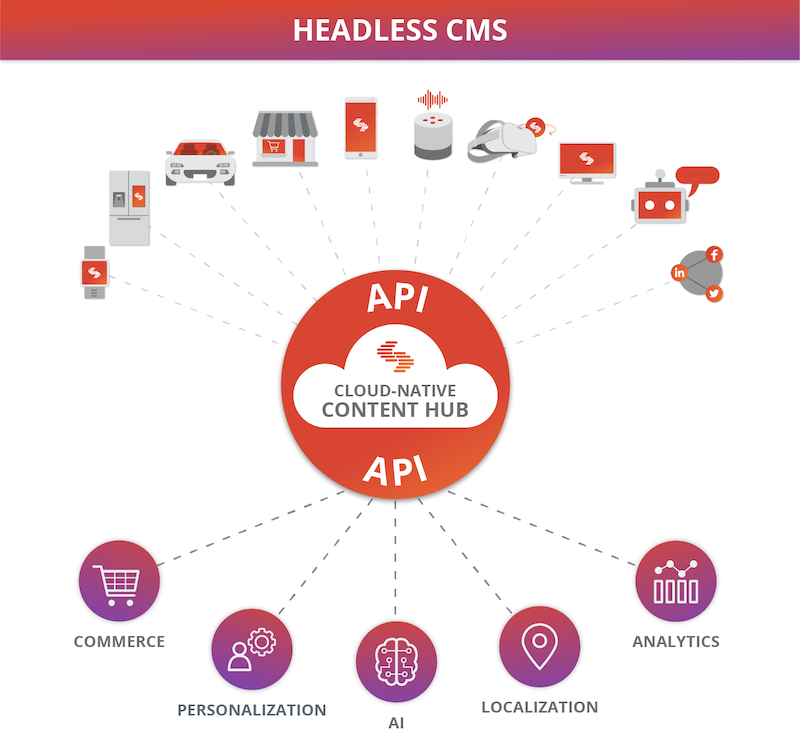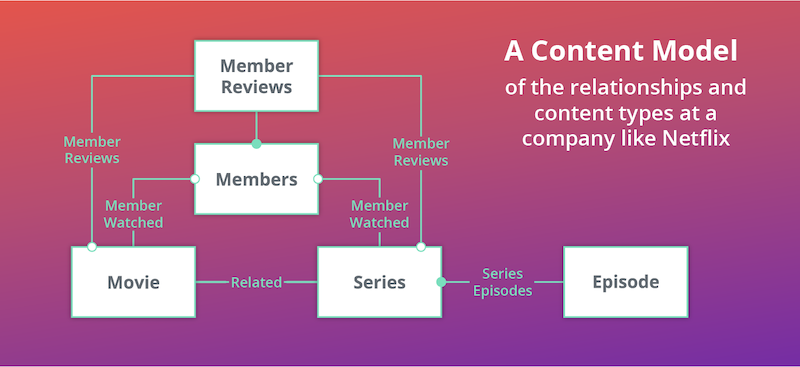CMS? API? Front end? Back end? Headless? Content may still be king, but the tools and the language we use to work with it sure aren’t the same as they used to be.
If you’re having a hard time deciphering the geek speak while making sure your business stays on the cutting edge of content marketing technology, this guide was created for you.
What is a Headless CMS, and Why Is It Important?
A headless content management system (CMS) is the modern answer to the traditional, monolithic CMSes that ruled content management in the 1990s.
With a monolithic CMS, the content database layer (the back end or “body”) and the content presentation layer (the front end or “head”) are coupled together. This monolithic approach means that the content is permanently defined by how it’s designed. So it is difficult to use again on another platform or for another audience.
While this infrastructure made sense when only publishing static websites, it’s outdated for today’s business needs.
Headless CMS, on the other hand, is the latest in content management technology. It’s called “headless” because it decouples, or separates, the back end (the “body”) where content is created and stored from the content presentation layer (the “head”), where content is formatted for delivery.

With a headless CMS, the marketing and content team can create and store content collateral using flexible, reusable modules in a back-end repository.
At the same time, front-end designers and developers can work on creating the best display for that content, whether it’s going to be delivered to a website, a mobile application, a chatbot, or any other Internet of Things device.
An application programming interface (API) connects the front end and back end so content can be formatted and delivered in the way best suited for the channel, device and audience.
Already, over half of the people on earth are connected to the internet. And by 2030, the average consumer may own as many as 15 internet-connected devices.
There’s a proliferation of devices, platforms and people who are using them to connect with businesses around the clock. A headless CMS is the best chance brands have to keep up in this brave new world.
Do You Need a Headless CMS?
You might be surprised to hear us say that every organization doesn’t necessarily need a headless CMS. However, it may be for you if you’re in any of these situations:
- You’ve got a project that requires a custom design that can’t be accomplished with template-bound website builders.
- You regularly create and update your website content, articles or even products.
- You’re manually rewriting, reformating and pasting content into every new publishing platform.
- You’re already experiencing bottlenecks waiting for your development resources to make content changes.
- You have access to front-end development resources.
- You’re struggling under the weight of managing multiple CMSes.
- Your current content management process decides how you publish instead of enabling you to take a new approach.
Get a personalized demo of Contentstack to see how an API-first, headless CMS can work for your business. Our solutions engineers will show you the ropes and address your organization's most pressing needs.
How to Choose the Right Headless CMS
This choice is another “it depends” situation. Only you know your situation and needs well enough to choose the right CMS for your business. But the following questions may help you select a good fit:
- How much are you willing to spend?
- Can the solution be implemented on your timeline?
- Do you have access to the necessary resources (like developers)?
- Does it meet your performance needs (security, speed, scalability, etc.)?
- Do the features align with your long-term goals?
Of course, to answer that last question, it would help to understand the most critical headless CMS features.
Features to Consider When Shopping for a Headless CMS
In a technological environment that’s teeming with features ranging from the critical to the ridiculous, these are the handful we think most businesses should look for when buying a headless CMS.
Content Delivery APIs
One of the most defining features of a headless CMS is its APIs. A headless CMS is sometimes referred to as an API-first CMS. API-first means that your application was built from the ground up with APIs and revolves around delivering content to omnichannel devices and client applications.
APIs also make it possible to link different microservices and applications to each other. An API enables content to be pulled from repositories and distributed to websites, emails, apps, mobile devices, social media channels, chatbots, interactive displays, AR and VR experiences, and every other omnichannel development coming in the next few decades.
Don’t stop at just figuring out whether there is a content API or not. Dig deeper to make sure it’s high-quality and that there is suitable documentation and support so it’s easy for developers to use.
Integration Extensibility
A headless CMS should have extensions that enable integration with third-party business applications like PIM, CRM, email marketing programs, localization and translation tools and so on. These extended capabilities help you customize your content and marketing program to align with the most cutting-edge trends of the day — like personalization.

Enterprise-Ready Capabilities
Even if your business isn’t the size of an enterprise, that doesn’t mean it isn’t worth seeking out enterprise-compatible features like cloud hosting, around-the-clock availability, scalability, performance guarantees and tight security.
Developer Resources
There’s no reason a well-equipped headless CMS shouldn’t provide resources to help your developers get up and running quickly. These may include APIs, Software Development Kits (SDKs) so they can code in their preferred languages, webhooks to automate processes, and content migration tools to help move away from a legacy CMS.
Content Management Tools
If you’re interested in headless CMS for its omnichannel publishing capabilities, you probably have a team of marketers and content editors and managers. Free them from redundant, time-wasting tasks by adopting a headless CMS that includes all the classic, user-friendly content management features from approval workflows to automated publishing, permission management, translation, version control and more.

Reusable Content Models
A content model outlines the structure fields, and relationships between its content elements. It is the heart of what makes content in a headless CMS so easy to label, store, search, re-optimize and publish across various channels. Being able to reuse content is crucial when implementing a multi-site management strategy. Easy-to-use content modeling functionality is a must when it comes to choosing a headless CMS.
Reliable Customer Support
And last but certainly not least, trustworthy customer support. Are you able and welcomed to take a no-holds-barred test drive of the CMS before you commit? Will the people who helped you through onboarding be there to help when something goes wrong? What if it’s a night or a weekend? What if you aren’t paying for their highest tier package? Great, personal customer support is an often overlooked but vital feature when it comes to the tool you’re trusting with your business branding and continuity.
Dive Into a Real-Life Headless CMS
If you’ve done enough reading about headless CMS and want a closer look, request a personalized demo of Contentstack to see how an API-first, headless CMS can work for your business. Our solutions engineers will show you the ropes and address your organization's most pressing needs.